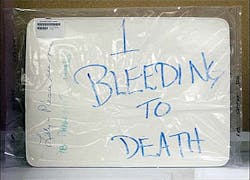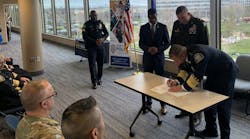“It was definitely the most awful day in my law enforcement career.”
In early spring of 1995, Grant Whitus and his sergeant, Tim Mossbrucker, were responding to shots fired at a Littleton, Colorado, grocery store. The gunman had already killed his wife, who worked at the store, and another person inside, and was prepared for a gunfight with police with multiple arms at hand near his vehicle. The gunman fired shots at the two policemen as they arrived, first at Whitus who was on foot, taking cover as he advanced on the shooter. Then at the sergeant who was in his vehicle weaving through cars and headed toward the gunman. The gunman shot the car, which caused part of the car to explode shrapnel and seriously injured the sergeant. Whitus then witnessed helplessly as the gunman shot the sergeant in the face.
That was Sgt. Tim Mossbrucker’s end of watch: Friday, April 28, 1995.
This is the way Whitus began learning how to confront homicidal mad men. In the years since, law enforcement across the nation saw many more shooters targeting places that would create big body counts—most vulnerably, in schools. From Columbine to Sandy Hook, police have learned many hard lessons and adapted with training and technology to better secure institutes of learning and protect the many lives inside.
The hard lesson
“I barely escaped with my life. That day we were so defeated,” Whitus says of the grocery store shooting. “But it was useful in teaching me.”
Whitus, a 26-year veteran of the Jefferson County Sheriff's Office in the Denver area, served 17 years of his law enforcement career on SWAT and retired as a sergeant.
In 1995, Whitus already had seven years on SWAT and was highly trained for a young man, he says. The hard lesson came as quickly as the rest of the gunfight: after killing the sergeant, the shooter suddenly gave up, raising his gun over his head. He’d been confronted by another man out of sight with a gun. And that was all it took to subdue him.
“As soon as somebody shot back at (the gunman), he quit,” Whitus says. “Probably the best lesson I’ve ever learned in my life. If I had shot at him right away, he might have stopped.”
It was four years later that Whitus, who rose to take Mossbrucker’s place in his department, was part of the SWAT team called out to respond to a shooting at a nearby school in Columbine. It would be another hard, horrible day; a day in which 12 students and one teacher lost their lives. But this time, it would capture the nation’s attention.
“The Columbine shootings shocked the nation because they hit close to home for people who were not accustomed to worrying about violent crime,” Chief Thomas Manger of the Montgomery County, in Maryland, wrote.
Manger wrote that the Columbine shooting incited a change in tactics, pivoting from a “Contain and negotiate” approach to rapid confrontation approach. That’s one of the tenets Whitus provides through his Colorado-based training company, Advanced Tactical Training (http://www.adtactrain.com).
Whitus’ upcoming book “Bullet Riddled,” expected to be published by Waldorf Publishing in September,” shares more about his and fellow officers’ experiences responding to the Columbine massacre and other incidents.
Whitus said it took a total of nearly 4 hours to locate the shooters, who were, by then, dead at their own hand. Police waited 30 minutes to enter the building.
“We were obviously so late we really couldn’t help people.” Whitus says. “Law enforcement can’t be connected to every church, mall and theater. It’s just not feasible. What we need to do is to train law enforcement to get through door immediately and stop the shooter. As soon as they get through the door.”
A different kind of killer in the classroom
Seven years after the killings at Columbine Whitus found himself running toward another grave high school incident in Bailey, Colorado, about 40 miles east of Columbine. A man entered Platte Canyon High School on Sept. 26, 2006, armed with a gun and a nefarious motivation. He picked a classroom, fired a shot into the air and sent the teacher and all but seven girls out of the room. Seven small blonde girls, whom he made face the wall and then sexually assaulted them, one by one.
Whitus and his SWAT and bomb teams were part of the response, and as a negotiator attempted to talk out the gunman, Whitus and other specialists began work to blow their way into the room before 4 p.m., when the gunman promised things would get worse. Fearing for the last two remaining girls the gunman hadn’t released and whom he’d sat in front of him to act as human shields, the team exploded a bomb on one wall and blew the left bottom portion of the classroom door in to give the team a chance to take the shooter out. Despite the plan, several things that had potential to go wrong, did.
A sniper shot blasted the gunman’s clavicle right after the breach, and one of the teens ran. But Emily Keyes was closest to the perpetrator, and he had his arm already around her head and shot her before the sniper could get the next bullet into his head. Keyes, 16, was killed. The gunman put the gun to his head and pulled the trigger.
His self-administered shot to head and the shot from the sniper went off at about the same time, Whitus says. The gunman died there inside the school, a place to which he had no known ties, and where officials had no advance indication that the school was in danger.
“The trick is we can’t keep (shooters) from getting in,” Whitus says. Years after the nation mourned Columbine, bad guys are still getting shots off at schools, most notably and widely reported:
April 16, 2007: 32 killed and 17 injured at Virginia Tech in Blacksburg, Virginia
Feb. 14, 2008: 5 killed, 21 injured at Northern Illinois University in DeKalb, Illinois
Dec. 14, 2012: 20 elementary-aged students and six adults killed, 2 injured at Sandy Hook Elementary in Sandy Hook, Connecticut
Oct. 1, 2015: 9 killed, 9 injured at Umpqua Community College in Roseburg, Oregon
“The history has shown us there’s no accurate way to predict it,” Whitus says. “But there is a way to respond to it and end it quicker.”
Room by room
As part of the SWAT team headed to Columbine High School on April 20, 1999, Whitus would face a new kind of evil and a new set of challenges in preserving life as the two now-infamous teenagers were enacting their plot to kill as many people as possible inside their school.
It took hours for him and the other good guys to get through a school full of people who were so terrified, they couldn’t move their feet to save their own lives. Whitus and the other responders had to physically pull them up before they’d move on their own.
“It was something I’d never seen in my life, and I’d been through a mass shooting. Someone with so much fear that they couldn’t move,” he says.
When the team finally breached the school through the cafeteria, it had been 30 minutes and information about where or how many shooters there were was fluctuating.
“We started looking for them room by room,” Whitus says. “We had so many different reports, at one point (we heard) there were eight or nine shooters. The children and teachers were so frightened they didn’t want to move (because) they felt they were safe (locked inside rooms).”
It started taking hours moving room to room, Whitus says.
“If there was a way, for instance, for law enforcement to link into every school (and) all communication and visual could go right to law enforcement, and we could tell the officers, ‘This is what he’s dressed in, this is where he is,’” Whitus says. “Absolutely, it would have assisted us in Columbine ten-fold.”
To move faster, the SWAT team would have needed to know which rooms held shooters, which rooms were safe, and which rooms had injured people inside. Today that can be communicated in the critical moment with specially designed technology.
South Western Communications, based in Newburgh, Indiana, has been helping schools put together security and communications systems for more than four decades. Director of Education Sales Wayne Henley says the company has put in technology like the Sielox Class System to help get life-saving intelligence to authorities quickly.
Sielox says its Class System allows educators to send color-coded alerts to authorities and allows law enforcement to view floor plans in real-time including information about what’s happening inside each room.
“In simple terms we want to know where the problem is; we want to identify the status of that problem. Is it a shooter? Is it a child down? What is the emergency, where is it at and how can I respond?” Henley says. Technology such as hearing live audio from a classroom and real-time surveillance visuals into common spaces are customized based on facility, and audio-visual combinations have already helped.
“We actually had someone in the school grab a young lady and was raping her,” Henley says. “It was after-hours, it was an emergency call-in. Someone in the classroom, when they heard the girl scream, pushed to send an alert to the officer who was across the county.” The officer, the only authority in the area on duty and far from the scene, was able to look into the school via a camera link and speak into the hallway. When he described what the attacker was wearing, the man stopped the attack and fled, Henley says.
Another in-building technology is looking to hear danger first to speed responses.
Woburn, Massachussetts-based Shooter Detection Systems’ Guardian removes the “human factor” in determining if a noise was gunfire or something innocuous, such as a car backfiring. The tool ensures nothing is left to interpretation that could take time or be false, according to the company. The aim is to speed response times and aid chances of catching a criminal and preserving life.
The indoor eye and ear of the Guardian sensors see an infrared flash and hear an acoustic bang when a shot is fired indoors. The system then notifies the people designated to start a response, the company says.
Books or locks: the money obstacle
“We know from Columbine that if the door was locked, those children (shooters) kept going,” Executive Director of the Secure Schools Alliance Robert Boyd says. “They were going for the path of least resistance.”
If we’ve known for decades that schools are targets for active shooters, why isn’t every school an impenetrable fortress teeming with technology? The main issues, says Boyd, are that the tools we have to keep bad guys out cost money and education professionals aren’t experts in access control and crisis communications.
“Don’t ever ask an educator to choose between books or locks,” Boyd says. “Our schools didn’t create the environment that we are living in, the environment that causes psychos to come into school buildings. They shouldn’t be expected to be the solutions.” Instead, he says, schools should have support from the agencies that are charged with protecting people.
That’s the drive behind the Secure Schools Alliance, the Wilmington, Delaware-based organization Boyd leads. The SSA is supported by groups like the Security Industry Association and access-control technology companies like Allegion. The SSA is working on a unified effort including construction industry representatives, educators, law enforcement and the security industry.
“These schools critical national assets and we need to protect them,” Boyd says. “We’re simply focusing on hardening the targets.”
Boyd says the solutions are affordable, but the schools can’t take from their coffers to beef up security. “The government needs to find a way to fund secure schools. And they’ve got to be implemented on a school-by-school basis, taking into account the needs, weaknesses and strengths of facilities,” Boyd says.
THe SSA is working to get the Federal Emergency Management Homeland Security Grant funds that states receive to be used to help schools buy the technologies that could help secure them. The organization is also pushing to implement a consistent assessment for school security.
Technology and a good man at the door
The worst day of Whitus’s career, outside the Littleton grocery store in 1995 and witnessing his supervisor and friend’s murder, was also the most formative, he says.
“(Colleague Sgt. Tim Mossbrucker’s death) was something that motivated me for the rest of my career. Such a tragic day, but it made me the person I needed to be: to be the SWAT leader I (would become).”
Seventeen years have gone by since Whitus was the first to see the dead faces of the Columbine killers on the CHS library floor, but the nation is still working to secure our schools. In a recent visit to Whitus’ teenage daughter’s school in Colorado, not far from Columbine High, he says he was able to walk in a side door and down the hall before someone asked him if he belonged there.
“I could have had access to 20 or 30 classrooms. I don’t know how many other entries there were in that school, but I had access.”
“Schools have to do a better job at security,” Whitus says. While technology can help, in his experience, Whitus says security means “one access in, one access out, and a good man at the door with a gun to see who comes and goes.”



